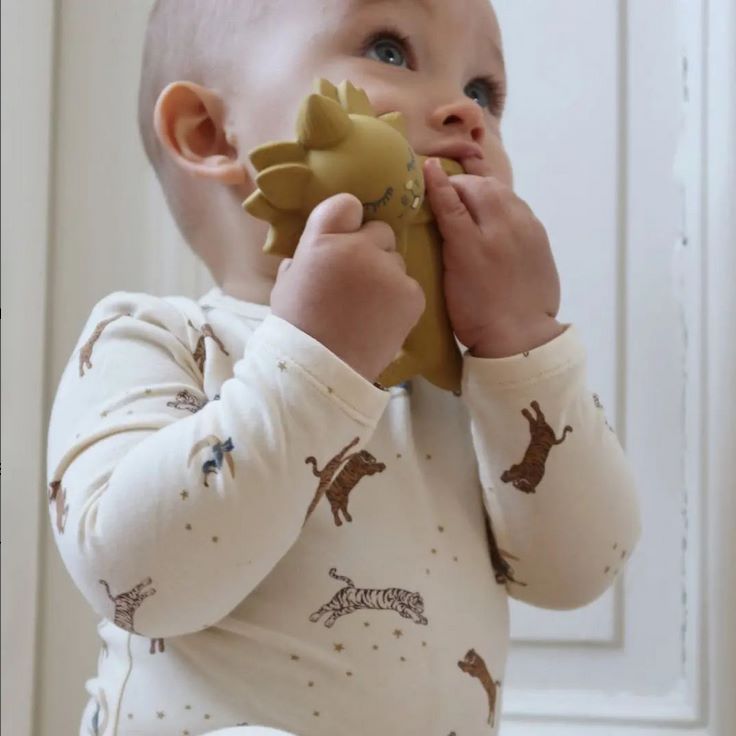The selection is huge!
Teething rings come in all colors, shapes and made from a variety of materials.
What should you pay attention to when buying a teething ring for your baby?
We'll tell you!
1. Baby begins to grasp:
On average, a baby begins to consciously grasp objects at 3-4 months of age. Shortly afterwards, he or she begins to bring these objects to his or her mouth and explore them orally.

At this point you are probably wondering what items you can offer your baby that are safe for your baby and that can further support his or her development.
But as I said, the selection is huge. Which material should you choose? Silicone? Wood? Plastic? Natural rubber? And which shape is ideal for little hands?

2. Age is the most important thing:
Well, to answer your question, YOU must first ask yourself a question:
How old is your baby?
Are you looking for a teething ring for your 4-month-old baby who started grasping objects a few days ago?
Or for your 8-month-old baby who is just teething?
Your baby has different needs at every age. That's why this question is crucial.
Depending on your baby's age, you may want to choose a different material, shape or weight (which is mainly determined by the material and shape).
3. Which material should I choose?
But let’s first look at the properties of the different materials and their advantages and disadvantages.
And it probably doesn't need to be specifically mentioned that a teething ring should be free of harmful substances. This is a requirement for all materials and all baby toys and products!
4. Sterilize:
There is some debate about whether a teething ring should or must be sterilized.
Do you sterilize your baby's pacifiers? Or other things he puts in his mouth? His water?
If you answer these questions with yes, it makes sense to sterilize the teething ring as well.
Sterilizing teething rings mainly makes sense in the first few months of life, i.e. when your baby uses their first teething ring. Once your baby is a little older, sterilization is no longer necessary.
Do you want to be able to sterilize your teething ring? Then you should choose a silicone teething ring (most silicone teething rings can be sterilized, but please always follow the manufacturer's instructions).Wood, natural rubber or fabric (cotton) is not the right choice in this case.
5. Cooling/teething:
If you want to support your baby during teething, then a teething ring with a structure (to massage the gums) or a coolable teething ring may be the right choice.
There are water-filled teething rings, but natural rubber can also be placed in the fridge for a cooling effect. But never in the freezer! (The effect lasts less long than with a water-filled one).
For what age?
So you see, the age of your baby is crucial. The first teething ring (at 4-5 months) must meet different criteria than a teething ring for a 6-12 month old baby who is teething.
6. Your baby’s first toy (4-5 months):

3. Do you want to be able to sterilize the teething ring? Then you should choose a silicone teething ring (most can be sterilized, but please always follow the manufacturer's instructions). Wood, natural rubber or fabric (cotton) are not the right choice in this case.
7. Teething rings for 6-12 month old babies:


Your baby has now grown stronger. Maybe he can even sit up. He can now certainly bring heavier objects to his mouth and also grasp and hold wider objects. The baby discovers his world mainly orally, i.e. with his mouth. Now you can offer your baby different materials to explore and support the baby in the development of his sensory perception. In addition, babies usually start teething from around 6 months. So he likes to bite on a teething ring not only to explore the different structures and materials, but also to reduce the unpleasant tension and pain caused by massaging the gums.
Choosing a coolable teething ring can also be the right choice. Cooling also relieves the pain. There are water-filled teething rings, but natural rubber can also be put in the fridge for a cooling effect. Never in the freezer. (The effect lasts less long than with a water-filled one, though).
So teething rings/toys for older babies ( 6-12 months ) may:
1. Be heavier and wider
2. They should encourage and support your baby in the phase of oral exploration. With different structures, materials, sounds (rattles, crackling, bells) and surfaces
3. They relieve teething pain with different structures/surfaces/materials and cooling
Summary:
When choosing the perfect teething ring for your baby, your baby’s age is crucial.Teething rings are the best first toy for your baby because (if chosen correctly) they are non-toxic, lightweight, slim and sterilizable.
Teething rings are ideal toys throughout your baby’s first year of life:
- They encourage oral exploration in a safe way with a variety of shapes, materials and sounds, because babies discover the world more with their mouths than with their eyes in the first few months.
- They support teething.
- In addition, a teething ring and biting promote the chewing muscles and thus chewing and eating behavior.

Also important to know: Exploring hands is a very important phase for babies and should never be prevented (e.g. with gloves).
Source images: Mushie, Konges Slojd

